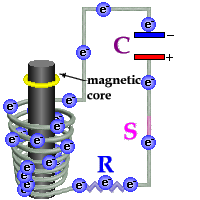Faraday's Electromagnetic Induction
SED 695B; Fall 2005
Principles illustrated:
Electromagnetic Induction


Standards addressed:
Physics 5f:
Students know magnetic materials and electric currents (moving electric
charges) are sources of magnetic fields and are subject to forces arising
from the magnetic fields of other sources.
- Primary Secondary Coil Induction Set (Science First item #10-140)
- 4.5V Battery
- Galvonometer
- Switch
- Aligator Clips (4)
- Paper Clips
Students may wonder how transformers and generators work. Here is described a potential lab or demonstration of Faraday's principle of electromagnetic induction. Since the copper coils (refered to as a loop) contain a changing electric charge, an object placed within the electric field will become charged (magnetized). When the rod is pushed in and out of the coils, the magnetic field around the coils is changed. This in turn makes the electrons (current) in the coil move. This can be observed by the alternating (+) and (-) movements on the galvanometer. Alternatively, or additionally, the apparatus can be rearranged so that an electrical current generated from a battery is passed through the coil. The rod provides a direction for the current and stabilizes it. Furthermore, the rod becomes magnatized and can be used to pick up small metal objects, like paper clips.
Background information:
Faraday’s Law of Induction
In words:
The induced EMF (voltage or potential difference) around a closed loop is equal to the instantaneous rate of change (derivative) of the magnetic flux through the loop.
In equation form:
![]()
There are three ways to change the magnetic flux through a loop:
- Change the magnetic field strength (increase, decrease) over the surface area
- Change the area of the loop (increase by expanding the loop, decrease by shrinking the loop)
- Change the angle between the surface defined by the loop and the magnetic field vector. Remember that flux is the integral of the dot product between B and dA.
![]()
Therefore changing the angle either increases or decreases the flux because the dot product depends on the sine of the angle between the vectors B and dA. This is how a generator works. A generator rotates a loop (actually multiple loops) of wire through a fixed magnetic field and induces a voltage around the loop by rapidly changing the flux through the loop as it rotates. That induced voltage around the loops causes a current to flow through the wire and that is the output current of the generator.
The negative sign indicates that the induced voltage is in a direction that creates a current that opposes the change in flux in the loop. This relationship is stated in Lenz’s Law.
Lenz’s Law:
The induced current in a loop of wire will be in a direction that opposes the change in flux through the loop. In other words, if the flux through the loop is being increased, then the induced current will create its own flux that will try to cancel out the increase in flux. If the flux through the loop is being decreased, then the induced current will be in a direction that tries to increase the flux through the loop.Procedure:
- Gather materials
- Connect the primary (larger) coil to the galvanometer using the aligator clips
- Move the rod in and out of the coil and observe the galvanometer move in the direction of the motion
- Reconfigure the wires and clips so that the battery completes the circuit with the large coil.
- Demonstrate that the rod, when placed within the coil, is now magnatized and will pick up paper clips, tacs, and staples.
- Use the same arrangement with the battery, this time using the smaller diameter coil. Note that, with its greater number of windings, the smaller diameter coil will produce a stronger magnatism than the larger coil. The rod in the smaller coil will pick up more clips.
- Record results in a data table
- Have students answer questions
- Brainstorm the "realworld" applications of electromagnetic induction
References & Links:
- http://micro.magnet.fsu.edu/electromag/java/faraday2/
- http://www.slcc.edu/schools/hum_sci/physics/tutor/2220/em_induction/
- http://regentsprep.org/Regents/physics/phys03/dinduction/default.htm